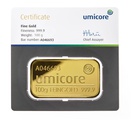Gold bar facts
Gold bars are one of the most popular ways to invest in the precious metal. They offer a straightforward, cost-effective way to buy pure gold. Below are a number of gold bar facts potential investors can consider before buying.
Which gold bar to buy?
- Ounce for ounce, the cheapest way to buy gold is in the form of bars, and the bigger the bar the better the value. This is simply because bars are easier to manufacture than coins and large bars are just as easy to make as small bars. Therefore an investor will get a lower margin and receive more gold for their money in a
12.5 kilo bar
than the same weight but in the form of coins.
- When asking yourself which gold bar to buy, the general guide would be the largest bar you can get within your investment budget. We're often asked about the differences between brands and new/pre-owned. When it comes to selling, a bullion trader (ourselves included) will be offering a price based on the amount of gold only. A 100 gram gold will be worth the same, no matter who it was made by, and whether it is new or second hand.
- Gold bars are mostly 24 carat pure gold. All of the bars we sell at BullionByPost are made from LBMA-approved refiners, and use 24 carat gold to ensure it is the highest purity possible.
- There are still many reasons to buy small coins or bars rather than large bars.
Small bars are easier to store and protect. They
are also easier to trade than expensive large bars and offer flexibility; you can't sell part of a 100g bar but you can sell one 10g bar from a collection of 10 at the same total weight.
Facts of gold bars
One of the interesting facts about gold bars is that there are two different methods of production; casting or minting. Casting involves simply pouring the gold into a rough mould. Minting is similar to coin production, with the gold bar pressed in a machine.
Typically, large bars are cast ingots and small bars are minted ingot. Minting/pressing gives a better appearance and a finer finish than casting, but requires more work and therefore a higher cost. For larger bars, given their size and intended purpose, they aren't typically for gifting, and are made as cheaply as possible for investors.
Both cast and minted bars are usually impressed with the manufacturers name, weight, and the fineness or purity. Large bars may carry serial numbers but very few are sold with certification. Small bars often come in sealed protective packages which may also carry a serial number as part of an assayer's card.
Certification of gold is not required for selling back to dealers in future. Customers often ask us why products don't always come with certification, and the truth is that refiners often do not make them. They are concerned with retaining strict accreditations, which they deem enough proof of the quality of their work. In addition, bullion dealers have specialist equipment to inspect precious metals and prove their weight and purity, so you can rest assured that we can identify your gold or silver for what it is.
At BullionByPost we only buy back bullion from LBMA (London Bullion Market Association) approved refiners. These bars and coins are the best of the best, produced by top refineries in Germany, Switzerland, Belgium and the United States. We buy from these brands and trust them, so buying back their products second-hand is a no brainer for us!
After buying back gold bars Bullion dealers will generally test the metal by cutting it and then sell it back to a refiner for reprocessing, which again negates any need for certification.
The simple truth is that gold is gold: investors buying physical gold should do their research and know who they are buying from. Read reviews, inspect their website, scope out their customer services. Investors should know that they have total ownership of their investment, without referral to banks, financial institutions and need no certificates or serial numbers. Their gold is easily
tested
and is worth whatever
the market is paying.
Weights and dimensions
Gold bars come in a huge spread of weights. The world's largest gold bar weighs 250kg, worth well over £6 million, and the smallest, referred to as biscuits, as little as 1 gram.
Troy ounces and grams are the most widely used measure for weighing gold. A
Troy ounce
is 31.1035 grams or 1.09714 of the standard British ounce. The less common
Tola weight,
at slightly over 11.33 grams, is popular in parts of Asia.
- How To Buy Gold
- How to Buy?
- Payment Options
- Delivery Options
- Gold Storage
- Storage at Brink's
- Gold Investment Guide
- Why buy gold?
- Is gold a good investment?
- Why physical gold?
- Best time to buy gold?
- Gold bars vs coins?
- Gold vs Silver
- Gold - Silver Ratio explained
- VAT on bullion
- CGT on bullion
- Legal tender coins
- Top 5 Gold Investments
- Top 5 Silver Investments
- Gold vs ISAs
- Gold vs Buy-to-Let
- Gold vs FTSE 100
- Gold vs Bitcoin
- Where to buy gold?
- Why buy from us?
- Where to sell gold?
- Coin Shops
- Gold Price Forecasts
- Top 10 Gold Producers
- Top 10 Gold Reserves
- Gold Britannia vs Sovereign
- Britannia coin designs
- Sovereign coin designs
- Sovereign Mintages
- Sovereign mint marks
- British coin specs
- What is a proof coin?
- Royal Mint bullion
- The Queen's Beasts
- Royal Mint Lunar Coins
- Bullion Refiners
- British coin mints
- Krugerrands
- Gold Tola - India & Pakistan
- Bullion Index











